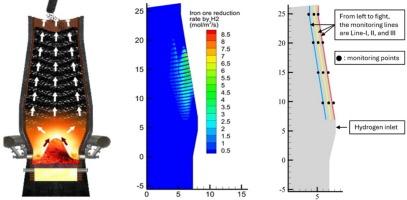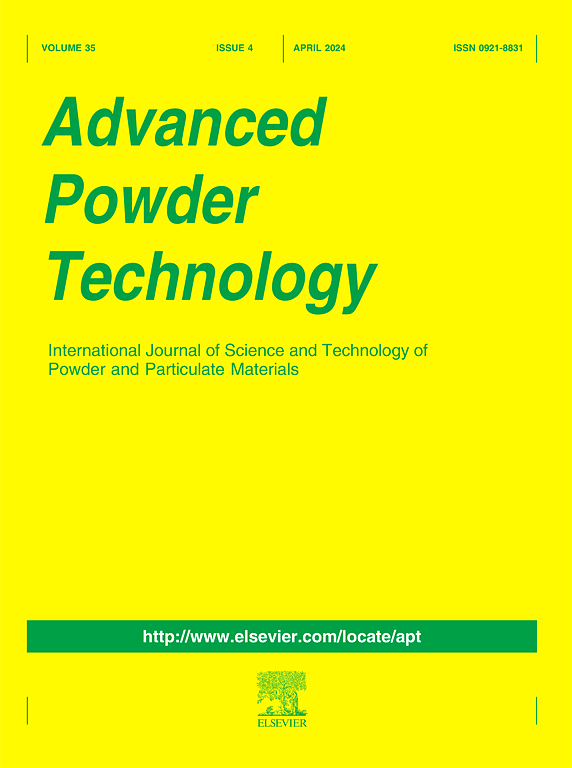Transient-state behaviours of blast furnace ironmaking: the role of shaft-injected hydrogen
IF 4.2
2区 工程技术
Q2 ENGINEERING, CHEMICAL
引用次数: 0
Abstract
Hydrogen shaft injection into blast furnaces (BFs) has a large potential to eliminate carbon dioxide emissions, yet the temporal evolution of thermal and chemical states following shaft-injected hydrogen utilisation has not been reported in the open literature. In this research, a recently developed transient-state multifluid BF model is applied to elucidate the temporal evolution of in-furnace phenomena. Besides, a domain-average method is adopted to analyse the extensive simulation data to determine the time required to attain the next steady-like state. The results show that the evolution of thermal and chemical conditions varies across different regions, with distinct characteristics near the furnace wall. The shifts in iron oxide reduction behaviour are completed within 10 to 20 h after the new operation, and the transition time points to the next steady-like states of thermal and chemical conditions are different. As the hydrogen flow rate increases, the average transition time decreases. However, 2 to 4 days are required for the studied BF to reach a new steady-like state in the considered scenarios. The model offers a cost-effective approach to investigating the transient smelting characteristics of an ironmaking BF with hydrogen injection.

高炉炼铁的瞬态行为:轴注氢的作用
高炉(BFs)的氢轴注入具有消除二氧化碳排放的巨大潜力,但在公开文献中尚未报道轴注入氢利用后热和化学状态的时间演变。本研究采用一种新建立的高炉瞬态多流体模型来解释炉内现象的时间演化。此外,采用域平均法对大量仿真数据进行分析,确定达到下一个类稳态所需的时间。结果表明:不同区域的热化学条件演化存在差异,且在炉壁附近特征明显;氧化铁还原行为的转变在新操作后的10 ~ 20 h内完成,并且向下一个稳态和化学条件的过渡时间点不同。随着氢气流量的增加,平均转变时间减小。然而,在考虑的情况下,所研究的BF需要2到4天才能达到新的稳定状态。该模型为研究喷氢炼铁高炉瞬态熔炼特性提供了一种经济有效的方法。
本文章由计算机程序翻译,如有差异,请以英文原文为准。
求助全文
约1分钟内获得全文
求助全文
来源期刊

Advanced Powder Technology
工程技术-工程:化工
CiteScore
9.50
自引率
7.70%
发文量
424
审稿时长
55 days
期刊介绍:
The aim of Advanced Powder Technology is to meet the demand for an international journal that integrates all aspects of science and technology research on powder and particulate materials. The journal fulfills this purpose by publishing original research papers, rapid communications, reviews, and translated articles by prominent researchers worldwide.
The editorial work of Advanced Powder Technology, which was founded as the International Journal of the Society of Powder Technology, Japan, is now shared by distinguished board members, who operate in a unique framework designed to respond to the increasing global demand for articles on not only powder and particles, but also on various materials produced from them.
Advanced Powder Technology covers various areas, but a discussion of powder and particles is required in articles. Topics include: Production of powder and particulate materials in gases and liquids(nanoparticles, fine ceramics, pharmaceuticals, novel functional materials, etc.); Aerosol and colloidal processing; Powder and particle characterization; Dynamics and phenomena; Calculation and simulation (CFD, DEM, Monte Carlo method, population balance, etc.); Measurement and control of powder processes; Particle modification; Comminution; Powder handling and operations (storage, transport, granulation, separation, fluidization, etc.)
 求助内容:
求助内容: 应助结果提醒方式:
应助结果提醒方式:


